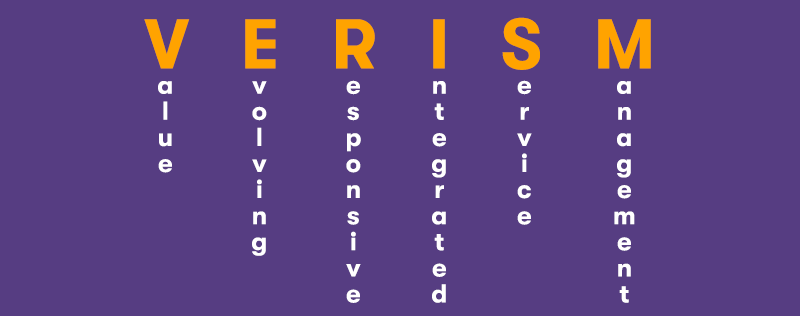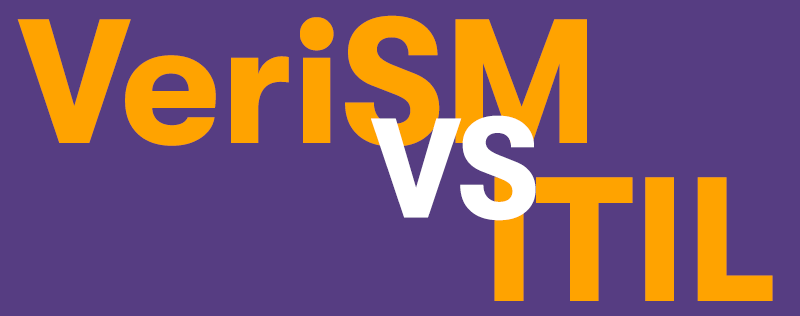VeriSM - Is it really the future of IT Service Management and ITIL®’s replacement?
For many years I have bashed on about how all of the various IT Frameworks (like ITIL®), Methodologies (like PRINCE2®), Processes (like Change and Incident), Approaches (like and DevOps) and Techniques (like Kepner-Tregoe) are interconnected.
I’ve also always argued that IT Service Management is the skeleton of IT (the skeletal structure of IT) and that it supports all of the other structures like the brain (decision making – whether to buy or build), the nervous system (monitoring, measuring and reporting) and the muscles (getting things done and doing things like supporting IT users).
At the core of my human analogy is the backbone (the spine) which for me is (ITAM) IT Asset Management.
Having been told by some of my colleagues that ITIL® is dead and is being replaced by VeriSM, I can confirm that in my opinion it is not. All VeriSM is doing is helping to join everything together. I suppose in my human analogy it could be considered as being both the connective tissue (holding the bits and bobs together) and also the venous structures carrying oxygen to the various parts of my body of IT.
Why not have a look at Claire Agutter’s video of what VeriSM is about and see what you think…
There is also a LinkedIn group that is worth joining https://www.linkedin.com/groups/13558044
What is VeriSM?
VeriSM is a service management approach designed to help organisations deliver high-quality products and services in a digital and fast-paced environment. It provides a flexible and adaptable framework that can be tailored to suit different business needs and industry sectors.
VeriSM takes into consideration the evolving nature of technology and the increasing importance of digital transformation. It emphasises the integration of various management practices and recognises that different approaches may be needed to manage different services within an organisation. Key principles of VeriSM include:
Focus on value
VeriSM encourages organisations to prioritise the creation of value for their customers and stakeholders. It promotes a customer-centric approach to service management, ensuring that services are aligned with business objectives and meet the needs of users.
Collaboration
VeriSM emphasises the importance of collaboration and breaking down silos within an organisation. It encourages cross-functional teams and departments to work together, share knowledge, and collaborate on service delivery.
Progressive management practices
VeriSM recognises that traditional service management practices may not be suitable for the rapidly changing digital landscape. It encourages organisations to adopt progressive management practices, such as Agile, DevOps, and Lean, to enhance service delivery and improve responsiveness.
Tailor-made solutions
VeriSM acknowledges that there is no one-size-fits-all approach to service management. It encourages organisations to select and combine management practices that best suit their specific context, industry, and business objectives. It promotes flexibility and adaptability in designing service management solutions.
Governance
VeriSM highlights the importance of governance in ensuring that services are managed effectively and comply with regulatory requirements. It promotes a balanced approach to governance, focusing on achieving outcomes while managing risks.
VeriSM provides guidance on various aspects of service management, including service culture, organisational structure, emerging technologies, service design, service transition, service operation, and continual improvement. It is a holistic approach that aims to create a service management ecosystem that is responsive, value-driven, and adaptable to changing business needs and technological advancements.
What Does VeriSM Stand For?

If you are wondering what VeriSM stands for its:
- Value-driven
- Evolving
- Responsive
- Integrated
- Service
- Management
What are the Main Features of VeriSM?
VeriSM incorporates several key features that distinguish it as a service management approach. The main features of VeriSM include:
Service Management Principles
VeriSM defines a set of service management principles that guide organisations in delivering value-driven services. These principles emphasise a customer-centric approach, collaboration, adaptability, and the integration of various management practices.
Management Mesh
The VeriSM Management Mesh is a framework that illustrates the integration and combination of different management practices to meet specific service management needs. It recognises that different services may require different approaches and encourages organisations to tailor their management practices accordingly.
Service Management Organisational Structure
VeriSM acknowledges that the organisational structure and culture play a crucial role in effective service management. It provides guidance on designing and adapting the organisational structure to support service delivery, collaboration, and innovation.
Emerging Technologies
VeriSM recognises the impact of emerging technologies on service management. It provides insights into how organisations can leverage technologies such as artificial intelligence, automation, and cloud computing to enhance service delivery, improve efficiency, and drive innovation.
Service Lifecycle
VeriSM takes a holistic view of the service lifecycle, encompassing service strategy, service design, service transition, service operation, and continual improvement. It provides guidance on how organisations can effectively manage each stage of the lifecycle to deliver value to customers and stakeholders.
Governance and Risk Management
VeriSM emphasises the importance of governance and risk management in service management. It provides guidance on establishing governance structures, defining roles and responsibilities, and managing risks to ensure compliance, accountability, and effective decision-making.
Service Culture
VeriSM recognises the significance of fostering a service-oriented culture within an organisation. It encourages organisations to cultivate a mindset of customer focus, collaboration, continuous learning, and improvement across all levels of the organisation.
Flexibility and Adaptability
VeriSM promotes flexibility and adaptability in service management. It encourages organisations to tailor their approach based on their specific context, industry, and business objectives. It recognises that service management practices need to evolve and adapt to meet changing technological advancements and market demands.
These features collectively contribute to the unique characteristics and benefits of VeriSM, enabling organisations to deliver effective and value-driven services in today's dynamic business environment.
ITIL vs VeriSM. Which is Better?

ITIL 4 and VeriSM are both service management frameworks that aim to help organisations deliver high-quality services. While they share common goals, there are some key differences between ITIL 4 and VeriSM:
Scope and Focus:
ITIL 4 (Information Technology Infrastructure Library) focuses primarily on IT service management. It provides a comprehensive framework that covers a wide range of IT service management processes, practices, and concepts.
VeriSM, on the other hand, has a broader scope and is not limited to IT. It recognises that services can be delivered across various domains and industries, including IT, HR, finance, facilities, and more. VeriSM emphasises the integration of management practices from different domains to meet service management needs.
Approach:
ITIL 4 follows a more prescriptive approach, providing detailed guidance and best practices for IT service management processes. It offers a structured framework that organisations can follow to implement IT service management practices effectively.
VeriSM takes a more flexible and adaptable approach. It encourages organisations to select and combine management practices from various frameworks, methodologies, and standards that best suit their specific context and needs. VeriSM provides guidance on how to integrate and tailor these practices to achieve effective service management.
Service Lifecycle:
ITIL Version 3, ITIL4 and VeriSM recognise the service lifecycle, consisting of stages such as service strategy, service design, service transition, service operation, and continual improvement.
ITIL Version 3 provides detailed processes and practices for each stage of the service lifecycle, focusing on IT-specific activities and considerations.
ITIL 4 does not really discuss the Service Lifecycle in its documentation but rather focuses on the co-creation of value across the value chain. ITIL4 recognises the service lifecycle stages by saying that it builds on version 3 it does not replace it.
VeriSM takes a broader view of the service lifecycle, encompassing various domains and services. It provides high-level guidance on managing the service lifecycle and emphasises the integration of practices from different domains.
Integration of Emerging Technologies:
ITIL 4 addresses the integration of emerging technologies, such as cloud computing, artificial intelligence, and automation, within the context of IT service management. It provides guidance on leveraging these technologies to enhance service delivery and efficiency.
VeriSM also recognises the impact of emerging technologies but provides more comprehensive guidance on how organisations can adopt and integrate these technologies across different service domains, not limited to IT.
Governance and Risk Management:
Both ITIL 4 and VeriSM emphasise the importance of governance and risk management in service management.
ITIL 4 provides detailed guidance on establishing governance structures, defining roles and responsibilities, and managing risks within the IT service management context.
VeriSM also addresses governance and risk management but provides more general guidance applicable to a broader range of service domains, considering different practices and frameworks beyond IT.
Ultimately, the choice between ITIL 4 and VeriSM depends on the specific needs, context, and scope of the organisation. ITIL 4 is more focused on IT service management and provides detailed processes and practices, while VeriSM offers a broader and more flexible approach, applicable to various service domains. Organisations may choose to adopt either framework or combine elements from both based on their requirements.
What are the Advantages of VeriSM?
VeriSM offers several advantages for organisations implementing this service management approach. Here are some key advantages of VeriSM:
Flexibility and Adaptability
VeriSM promotes flexibility and adaptability in service management. It recognises that different organisations have unique contexts, requirements, and service domains. VeriSM allows organisations to tailor their service management practices by selecting and integrating management practices from various frameworks, methodologies, and standards. This flexibility enables organisations to create a customised approach that aligns with their specific needs and industry.
Integration of Management Practices
VeriSM emphasises the integration of management practices from different domains and disciplines. It recognises that services are delivered through various functions and departments within an organisation. By integrating these practices, VeriSM encourages collaboration, knowledge sharing, and breaking down silos. This integration enables organisations to manage services holistically and achieve better coordination and efficiency.
Focus on Value and Customer Satisfaction
VeriSM places a strong emphasis on delivering value to customers and stakeholders. It encourages organisations to align their services with business objectives and customer needs. By adopting a customer-centric approach, VeriSM helps organisations ensure that their services are designed, delivered, and continuously improved to provide maximum value and enhance customer satisfaction.
Agile and Responsive Service Delivery
VeriSM recognises the need for organisations to be agile and responsive in today's fast-paced and rapidly changing business environment. It promotes the adoption of progressive management practices, such as Agile, DevOps, and Lean, to enhance service delivery speed, flexibility, and responsiveness. By embracing these practices, organisations can adapt to changing customer demands and market trends more effectively.
Holistic Service Lifecycle Management
VeriSM takes a holistic view of the service lifecycle, covering various stages from service strategy to continual improvement. It provides guidance on managing the entire lifecycle, including service design, transition, operation, and improvement. This holistic approach ensures that services are well-planned, effectively implemented, efficiently operated, and continuously optimised for better performance and value delivery.
Recognition of Emerging Technologies
VeriSM acknowledges the impact of emerging technologies on service management. It provides insights into how organisations can leverage technologies such as artificial intelligence, automation, cloud computing, and more. By integrating these technologies strategically, organisations can enhance service quality, efficiency, and innovation.
Governance and Risk Management
VeriSM emphasises the importance of governance and risk management in service management. It provides guidance on establishing governance structures, defining roles and responsibilities, and managing risks to ensure compliance, accountability, and effective decision-making. This focus on governance helps organisations maintain control, mitigate risks, and ensure service delivery aligns with regulatory and industry requirements.
Overall, VeriSM offers organisations a flexible, adaptable, and customer-centric approach to service management. It promotes integration, value delivery, responsiveness, and continuous improvement, enabling organisations to effectively navigate the complex challenges of the digital era and deliver high-quality services to their customers and stakeholders.
Where Can You Learn More About VeriSM?
There are three levels of VeriSM accreditation and certification:
VeriSM™ Foundation
VeriSM Foundation is a 2-day training course that introduces participants to the fundamental concepts and principles of the VeriSM service management approach. The course covers topics such as service management principles, the VeriSM model, and the service lifecycle. It provides a solid foundation for understanding and applying VeriSM in practice.
VeriSM™ Essentials
VeriSM Essentials is a 1-day training course providing a comprehensive introduction to VeriSM service management. Participants gain understanding of key concepts, principles, and practices, including the VeriSM model, service organisation and culture, and service lifecycle. The course equips individuals to apply VeriSM principles and enhance service delivery in their organisations.
VeriSM™ Professional
Our VeriSM™ Professional 3-day training course will prove your ability to create and use a Management Mesh that is based on the organisation’s current portfolio, principles, and governance needs. After creating or adapting the Management Mesh, a VeriSM™ Professional is able to manage the product or service through the Define, Produce, Provide and Respond stages.
Final Notes on VeriSM
While ITIL 4 focuses on IT service management and offers detailed processes and practices, VeriSM takes a broader approach, encompassing various service domains and promoting flexibility and adaptability. VeriSM stands out with its emphasis on integrating management practices, customer-centricity, agility, and holistic service lifecycle management.
The advantages of VeriSM are numerous. Its flexibility allows organisations to tailor their service management practices to their specific needs and industry context. By integrating management practices from various domains, VeriSM fosters collaboration and efficiency across different functions. Moreover, VeriSM's customer-centric approach ensures that services are designed and delivered to maximise value and customer satisfaction.
VeriSM also recognises the importance of being agile and responsive in today's fast-paced environment. It encourages the adoption of progressive management practices, enabling organisations to adapt to changing demands and market trends. The holistic approach to service lifecycle management provided by VeriSM ensures that services are well-planned, implemented, operated, and continuously improved.
In conclusion, VeriSM offers organisations a flexible, adaptable, and customer-centric approach to service management. By embracing VeriSM, organisations can integrate practices, deliver value, be responsive, and continually improve their services. In the fast-paced digital era, VeriSM equips organisations with the tools and mindset needed to thrive in delivering high-quality services that drive success and customer satisfaction.
To round off this blog, i will leave you with these VeriSM quotes:
"VeriSM supports how to use all organisational capabilities, from IT to marketing, finance to customer service, to deliver value."
"VeriSM is a Service Management approach, specifically tailored to support organisations to help them succeed in the world of digital services."
“VeriSM shows organisations how they can adopt a range of management practices in a flexible way to deliver the right product or service at the right time to their users"
That's the end of this post, but before you go, you might be interested in our ITIL® 4 Foundation Certificate page.
Or why not take a look at this post looking at the roles of an ITIL service transition manager?


